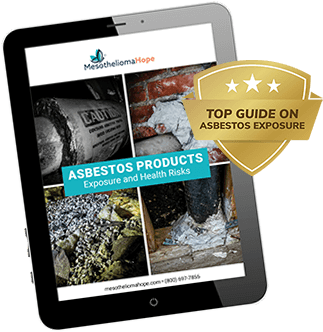Gaskets and Asbestos Exposure
For most of the twentieth century, asbestos gaskets were out of sight and out of mind. However, gaskets played an enormously important role in so many mechanical applications.
They allowed imperfect metal surfaces to mate and seal. Gaskets compressed when tightened and maintained high pressures in contained areas while prohibiting the transfer of liquids and chemicals. They also needed to withstand high heat while staying stable for extended periods.
At one time, asbestos was the prime choice for gasket material.
Asbestos was often blended with other materials to form gasket compounds. The range of asbestos content could be anywhere from as low as 5% to nearly pure.
Asbestos was considered the perfect gasket material because it was:
- Chemical resistant
- Fireproof
- Heat resistant
- Inexpensive
- Non-conductive
- Non-corrosive
- Readily available
- Stable
Asbestos gasket material was also easy to cut, shape, form, and blend with other materials like metal and cement.
Although many gaskets were formed in factories, often workers made gaskets on site. This process was common in specialized situations where commercial, ready-made gaskets were unavailable.
Common Types of Asbestos Gaskets
Asbestos allowed companies to make a wide variety of gaskets. The material could be combined with metal, plastic, or synthetic materials to make gaskets of all shapes, sizes, and purposes.
By the 1970s, asbestos-containing gaskets could found in every conceivable application across America. This was in part due to asbestos, which made the gaskets extremely durable.
The most common types of asbestos gaskets included:
- Rope gaskets: Much like other asbestos rope products, rope gaskets used white asbestos fibers to reduce flammability. In the present, most rope gaskets are made out of fiberglass and not asbestos.
- Ring gaskets: Ring gaskets are typically made out of metal and are designed to withstand high pressure and heat. They are often used in the production of oil and other natural gases. They are also known as ring-type joints gaskets. Ring gaskets can be oval, circular, or even octagonal in shape.
- Sheet gaskets: These were the most common type of asbestos-containing gasket, and were usually made of synthetic plastic. They were hand-cut and manufactured right on the job site. Sheet gaskets were used to seal pipes, tanks, and other containers.
- Spiral-wound gaskets: Spiral-wound gaskets are used to seal manholes, boilers, and other high-pressure containers. Major gasket companies like Flexatillic and Garlock produced spiral-wound gaskets.
Despite this, many asbestos gaskets installed before the ban are still in place today. Unsuspecting workers could be exposed to asbestos fibers as they remove and replace these old, worn-out gaskets.
Asbestos Gasket Applications
Every mechanical component joint used gasket materials.
In low-pressure and minimal heat applications, sealants like grease or cloth were common. However, when temperatures climbed and pressures increased, a hardier gasket substance was needed. Many manufacturers turned to asbestos for this reason.
Mechanical workers used asbestos to make gaskets for:
- Chemical plants: Chemical-producing factories used asbestos gaskets where reaction risks were present. Asbestos was chemically inert and wouldn’t react to other materials.
- Electrical generating stations: High voltages were ever-present, and asbestos gaskets in generators insulated components from shorts and groundings.
- Furnaces and boilers: Extreme heat and combustible materials were contained by asbestos gaskets.
- Gasoline and diesel engines: Asbestos head gaskets were exclusively used to seal combustion chambers and control coolant pressures.
- Shipbuilding flanges: Ships required large gaskets to seal flanges where water control was an issue. Asbestos was impervious to corrosion from saltwater.
Many workers were exposed to asbestos as they installed, repaired, or removed asbestos gaskets from these areas.
Workers at Risk
In order for gaskets to work properly, they had to be properly installed and maintained by skilled workers. Gaskets were used to seal surfaces, pipes, and high-pressure environments in many different industries, so thousands of workers handled gaskets on a regular basis.
However, since asbestos companies hid the deadly facts about their products, many of those who had to remove, install, or manufacture gaskets could be at risk of mesothelioma today.
Jobs with a high risk of asbestos exposure from gaskets include:
- Boilermakers
- Construction workers
- Chemical plant workers
- Factory workers
- Mechanics
- Pipefitters
- Plumbers
- Shipyard workers
Top Brands and Manufacturers of Gaskets
Though many gaskets contained asbestos, there are a few notable companies that made these products.
Major asbestos gasket companies included:
- Flexitallic: This company introduced the spiral wound gasket in 1912 when asbestos use was ramping up in the United States. Flexatillic is still in business, and its products no longer contain asbestos.
- Garlock: Garlock manufactured gaskets that contained white asbestos. The company filed for Chapter 11 bankruptcy in 2010 in the face of many lawsuits. Garlock has fought back against accusations that its gaskets were dangerous — even after establishing a trust fund to help victims.
- Goodyear Tire & Rubber Company: Goodyear manufactured gaskets under the Durabla and Cranite brand names. In recent years, Goodyear has been named in several lawsuits that allege its asbestos-containing products led to serious illnesses.
- John Crane: Also known as Crane Company, this company made and sold asbestos gaskets to the military. Since 2014, the company has gone to trial twice in asbestos lawsuits.
Other companies that produced asbestos gaskets included:
- Anchor Packing Company
- Armstrong Cork Company
- Dana Corporation (Victor Manufacturing & Gasket Company)
- General Gasket Corporation
- Johns-Manville
- Parker Seal Gaskets
- Raybestos-Manhattan, Inc.
- Standco Rubber Gaskets
Today, these companies have been held accountable for their actions.
After the health risks were known, many asbestos companies faced lawsuits from those who had gotten sick. Some went out of business as a result.
Larger companies established trust funds to pay their victims to stay in business.
Types of Asbestos Used in Gaskets
There are two main classes of asbestos: serpentine and amphibole. Both asbestos types were used to make gaskets — and both types are dangerous.
Serpentine Asbestos
The only recognized member of the serpentine asbestos classification is chrysotile asbestos.
Chrysotile asbestos is also called white asbestos. When an individual is looking under a microscope, chrysotile asbestos fibers appear serpent-shaped with soft edges.
Chrysotile asbestos was by far the most common asbestos material used in making gaskets.
Amphibole Asbestos
The lesser-common asbestos class used in gasket making was amphibole asbestos. It appears as a crystal with numerous sharp spikes.
There are five different forms of amphibole asbestos with amosite asbestos being the main sub-class used in gaskets. Amosite was used in high heat and corrosive situations.
Amphibole asbestos exposure is much more dangerous than chrysotile fibers, but that doesn’t make chrysotile gasket materials safe.
Asbestos Gaskets and Mesothelioma
Mesothelioma is a fatal form of lung cancer.
Its sole cause is exposure to asbestos fibers. That includes both chrysotile and amphibole asbestos particles.
Asbestos fibers became airborne in factory manufacturing plants and at on-site repair locations. When unprotected workers inhaled these tiny particles, they attached to workers’ lung linings (mesothelium).
Once embedded in the mesothelium, asbestos fibers don’t release. They stay in the mesothelium forever and eventually build scar tissue.
There is an extended latency period, but this scar tissue may turn tumorous and become a deadly disease called mesothelioma.
Compensation for Mesothelioma Victims
Although advanced mesothelioma is incurable, victims can receive financial compensation.
This compensation may be available to help pay for:
- Lost income
- Medical costs
- Personal injury damages
Families of mesothelioma victims can sue negligent asbestos material manufacturers and suppliers on their behalf. They can also file lawsuits in wrongful death cases.




